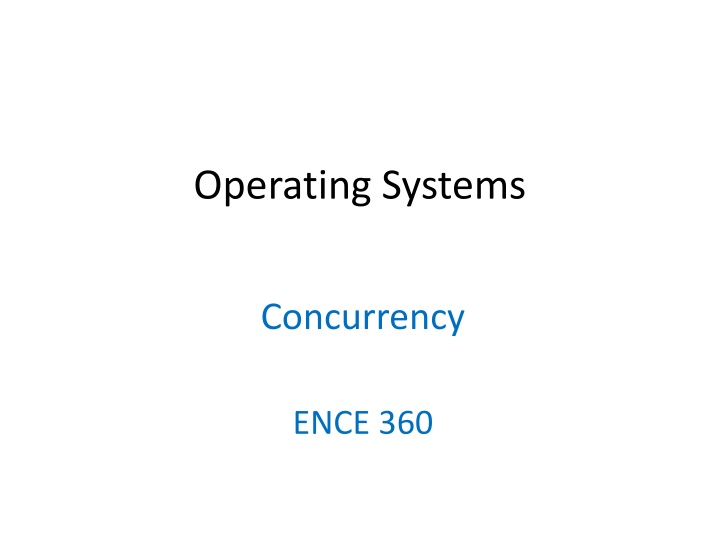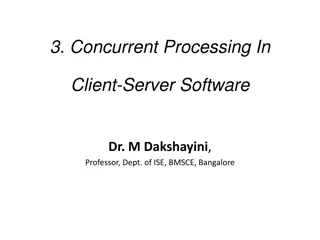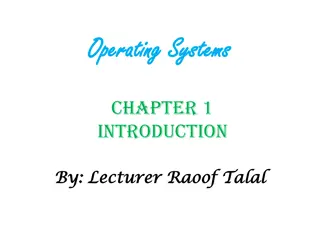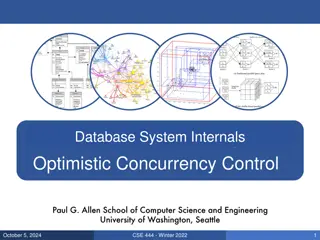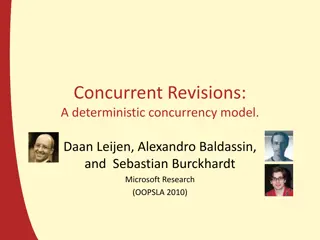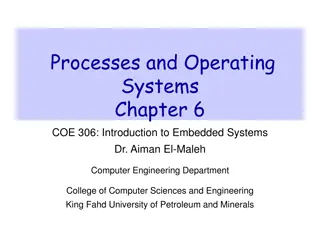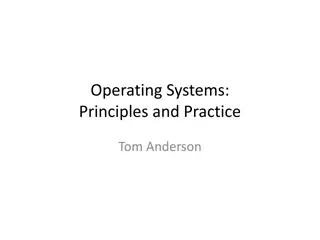Operating Systems Concurrency: Solutions to Classic Problems
Delve into the heart of concurrency issues in operating systems, exploring synchronization primitives, atomic actions, and thread management. Learn how to address race conditions and ensure the efficient and correct execution of concurrent tasks.
Download Presentation

Please find below an Image/Link to download the presentation.
The content on the website is provided AS IS for your information and personal use only. It may not be sold, licensed, or shared on other websites without obtaining consent from the author.If you encounter any issues during the download, it is possible that the publisher has removed the file from their server.
You are allowed to download the files provided on this website for personal or commercial use, subject to the condition that they are used lawfully. All files are the property of their respective owners.
The content on the website is provided AS IS for your information and personal use only. It may not be sold, licensed, or shared on other websites without obtaining consent from the author.
E N D
Presentation Transcript
Operating Systems Concurrency ENCE 360
Outline Introduction Solutions Classic Problems Chapter 26, 28, 31 OPERATING SYSTEMS: THREE EASY PIECES By Arpaci-Dusseau and Arpaci-Dusseau Chapter 2.3 MODERN OPERATING SYSTEMS (MOS) By Andrew Tanenbaum
68 prompt% threads-v0 100000 Initial value: 0 Final value: 200000 69 prompt% threads-v0 100000 Initial value: 0 Final value: 146796 A long time ago, Remember day 1? Yes, single number, but what if bank account? What if print spooler? What if database? Thread 0 Paycheck Thread 1 Buy fancy new TV Thread 2 Thread 3 Roommate pays rent Buying a video game retrieve balance add 450 to balance store balance retrieve balance subtract 450 from balance store balance retrieve balance add 300 to balance store balance retrieve balance subtract 50 from balance store balance
The Heart of the Problem Display information from object file - machine instructions: objdump -source thread-v0 Source code from -g flag [line 415] g_counter++; 400c38: 8b 05 6e 14 20 00 mov 0x201465,%eax # 6020ac <g_counter> 400c3e: 83 c0 01 add $0x1,%eax 400c41: 89 05 65 14 20 00 mov %eax,0x201465 # 6020ac <g_counter> Address Object code Assembly code Reference location Let s zoom in
The Heart of the Problem (Zoom) mov g_counter %eax add 1 %eax mov %eax g_counter mov 0x20146e(%rip),%eax add $0x1,%eax mov %eax,0x201465(%rip) critical section Counter is 50. Thread T1 & T2, one processor. WCGW? race condition Not 52!
The Heart of the Problem 3 not 1 mov g_counter %eax add 1 %eax mov %eax g_counter 3 operations instead of 1. What if had: memory-add 0x201465 1 Atomic action can t be interrupted Seems simple. Problem solved! But what if wanted to subtract 1 , or add 10 , or atomic update of B-tree Won t be atomic instructions for everything!
The Heart of the Solution Instead, provide synchronization primitives Programmer can use for atomicity (and more) THE CRUX OF THE PROBLEM: HOW TO PROVIDE SUPPORT FOR SYNCHRONIZATION? What synchronization primitives should be provided? What support needed from hardware to build? How to make correct and efficient? How do programmers use them?
Useful Terms* Critical section code that access shared resource (e.g., variable or data structure) Race condition arises when multiple threads/processes simultaneously enter critical section leading to non-deterministic outcome Indeterminant program program with 1+ race conditions, so output varies run to run Mutual exclusion method to guarantee only 1 thread/process active in critical section at a time * That all good systems-programmers (you!) should know
Outline Introduction Solutions Classic Problems (done) (next)
Illustration of Critical Region What basic mechanism can stop B from entering critical region when A in? Hint: just need to block access
How to Use a Lock // globally-allocated mutex lock_t mutex; lock(&mutex); x = x + 1; // critical region unlock(&mutex); See: thread-v1.c pthread_mutex_t lock; pthread_mutex_lock(&lock); x = x + 1; // or general CR pthread_mutex_unlock(&lock); THE CRUX: HOW TO BUILD A LOCK? How to build efficient lock? What hardware support is needed? What OS support?
Simple Lock Implementation - Disable Interrupts If no interrupts, no race condition void lock() { DisableInterrupts(); } void unlock() { EnableInterrupts(); } Time What is the potential problem? Hint: consider all sorts of user programs
Many Problems with Disabling Interrupts in General Privileged operations, so must trust user code But may never unlock! (unintentional or malicious) Does not work for multiprocessors Second processor may still access shared resource When interrupts off, subsequent ones may become lost E.g., disk operations Register s CPU1 Register s CPU2 Mem Disk
Lock Solution, Take 2 int mutex; // 0 -> lock available, 1 -> held void lock(int *mutex) { while (*mutex == 1) // TEST flag ; // spin-wait (do nothing) *mutex = 1; // now SET it! } This almost works but not quite. Why not? void unlock(int *mutex) { *mutex = 0; } Hint, has race condition - Can you spot it?
Lock Solution, Take 2 int mutex; // 0 -> lock available, 1 -> held void lock(int *mutex) { while (*mutex == 1) // TEST flag ; // spin-wait (do nothing) *mutex = 1; // now SET it! } This almost works not quite If can TEST mutex and SET it in atomic operation, would be ok void unlock(int *mutex) { *mutex = 0; } But aren t back to square 1? No! Only need hardware support for 1 operation build lock primitive
Synchronization Hardware Test and Set Test-and-Set: returns and modifies atomically int TestAndSet(int *mutex) { int temp; temp = *mutex; *mutex = true; return temp; } Done with hardware support. All modern computers since 1960 s e.g., x86 has compare-and-exchange Others: compare-and-swap, fetch- and-add, all atomic
Lock Solution, Take 3 int mutex; // 0 -> lock available, 1 -> held void lock(int *mutex) { while (TestAndSet(mutex)) // 1 if held ; // spin-wait (do nothing) // once here, have lock! } void unlock(int *mutex) { *mutex = 0; } Note, no need to protect unlock() (Exercise: why not?) Now, what is major remaining shortcoming? Hint: code works, but could be more efficient
Lock Solution, Take 4 int mutex; // 0 -> lock available, 1 -> held void lock(int *mutex) { while (TestAndSet(mutex)) { queueAdd(*mutex); park(); // put process to sleep } } Note: almost right, but need to protect queue, too (see OSTEP, 28.14 for final touch) void unlock(int *mutex) { *mutex = 0; if (!queueEmpty(*mutex)) unpark(); // wake up process }
Synchronization Primitive - Semaphore int sem_wait(sem_t &s) { s = s - 1 if (s < 0) add process to queue and sleep } Special integer, provided by OS Only accessible through two routines: sem_post() sem_wait() Both routines are atomic int sem_post(sem_t &s) { s = s + 1 if (s <= 0) remove process from queue and wake } Operational Model value of counter = number of procs that may pass before closed counter <= 0 gate closed! blocked process "waits" in Q counter < 0 number of processes waiting in Q
How to Use a Semaphore semaphore mutex; // globally-allocated wait(&mutex); x = x + 1; // critical region signal(&mutex); Easy, peasy! And available on most operating systems Can use for general synchronization problems (next)
SOS: Semaphore See: semaphore.c Design Technique Reducing Problem to Special Case How does the OS protect access to the semaphore integer count? Previously said this was a bad idea why is it ok in this context? How else might the OS protect this critical region? Challenge: Implement attach and detach functions Other examples: name servers, on-line help /* Attach to OS semaphore */ int AttachSemaphore(int key); /* Deattach from sem id */ int DetachSemaphore(int sid);
Other Synchronization Primitives Monitors Condition Variables Events Execise: learn on own Fortunately, if have one (e.g,. Lock) can build others
Outline Introduction Solutions Classic Problems Dining Philosophers Readers-Writiers (done) (done) (next)
Dining Philosophers Philosophers Think Sit Eat Think Need 2 chopsticks to eat
Dining Philosophers Philosopher i: while (1) { /* think */ wait(chopstick[i]); wait(chopstick[i+1 % 5]); /* eat */ signal(chopstick[i]); signal(chopstick[i+1 % 5]); } For 5 Philosophers This almost works, but not quite. Why not? Solutions?
Dining Philosopher Solutions Allow at most N-1 to sit at a time Allow to pick up chopsticks only if both are available Asymmetric solution (odd L-R, even R-L)
Readers-Writers Readers only read the content of object Writers read and write the object Critical region, one of: 1. No processes 2. One or more readers (no writers) 3. One writer (nothing else) shared resource
Readers-Writers Shared: semaphore mutex; semaphore wrt; int readcount; Reader: wait(mutex); readcount = readcount + 1; if (readcount==1) wait(wrt); signal(mutex); /* read stuff */ wait(mutex); readcount = readcount - 1; if (readcount==0) signal(wrt); signal(mutex); Writer: wait(wrt) /* write stuff */ signal(wrt); Solution favors readers. Can you see why?
Other Classic Problems Bounded Buffer Sleeping Barber Bakery Algorithm Cigarette smokers If can model your problem as one of the above Solution Akin to Software Design Patterns
Outline Introduction Solutions Classic Problems (done) (done) (done)
